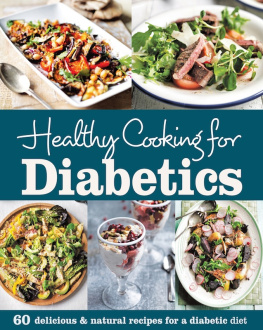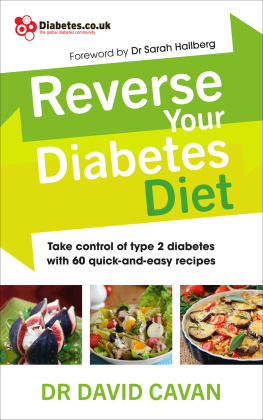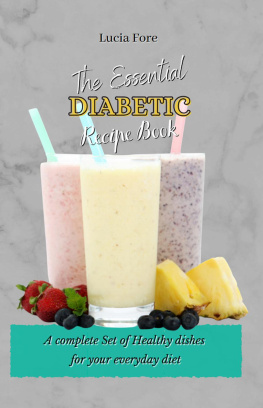If you have been diagnosed with diabetesor someone close to you hasit can be particularly upsetting. However, major advances in our understanding of this condition and in its treatment and management mean that today everything is possible in life, even if you are diabetic. While it is important to keep a careful watch on your food intakeespecially for people with type 1 diabetes and others who need to use insulinthere truly is still a whole world of delicious food out there for you to enjoy.
In recent years, health professionals have realized that it is not necessary for diabetics to eat as restricted a diet as once thought, nor is it necessary for them to forego eating the same meals as the rest of their family and friends. The diet suitable for the majority of diabetics is one that everyone can enjoya healthy, nutritious diet with no food groups excluded and with no obscure, hard-to-find ingredients. The diabetic diet is, in fact, a great way to eat for anyone who values their healthand their taste buds! Just a glance through these pages will give you a taste of the fantastic recipes that you, your friends, and your family can feast on.

Types of diabetes
Type 1 diabetes
Type 1 diabetes is most commonly diagnosed in childhood (and used to be known as juvenile diabetes for that reason) but it can actually begin at any age. It is also called insulin-dependent diabetes because, for those with type 1 diabetes, insulin is vital in its management.
Insulin is a hormone that helps your body use the glucose your body gets through the food you eat, providing you with energy. In type 1 diabetes, the body is unable to produce any insulin, so glucose builds up in the blood. Meanwhile, your body begins to look for sources of energy elsewhere and breaks down its fat stores or the proteins in your muscleswhich is why people with the disease can lose weight.
The causes are still being researched, but type 1 diabetes may be triggered by viruses or bacterial infections. Apart from weight loss, other usual symptoms include having to urinate more frequently (because the body is trying to flush out the unused, surplus glucose) and extreme tiredness. Currently, there is no cure for type 1 diabetes, but it can be treated and managed using insulin injections or an insulin pump in conjunction with a healthy lifestyle and diet.
Type 2 diabetes
Accounting for 90 percent of diabetes cases, type 2 diabetes is the most common type of diabetes. It develops when the body doesnt produce enough insulin, or when the insulin that is produced doesnt work properly (called insulin resistance).
Type 2 diabetes used to be called mid-life onset diabetes, because it does, indeed, affect a large number of people in mid-life, but there are growing numbers of younger people with the condition. Many experts link this surge to an increase in obesity and inactivity. High blood pressure and a large waist circumference (because fat stored around the midriff, known as visceral fat, appears to decrease insulin sensitivity and increase insulin resistance) are two risk factors.
Type 2 diabetes can cause serious long-term health problems, so it is important to be diagnosed early and control your blood glucose levels to prevent these complications. Blood sugar levels may be controlled with a healthy diet, weight loss, if necessary, and increased physical activity, although sometimes treatment with medication and/or insulin is also needed.
Gestational diabetes
This type of diabetes occurs for the first time in women during pregnancy and, in most cases, disappears after pregnancy is over. The cause is usually that the pregnant woman has a much higher than normal level of glucose in her blood and cant produce enough insulin to make her body able to use it all. It can be managed and treated in a similar way to type 2 diabetes.
What is a healthy diet for diabetics?
A healthy diet is important for everyone, but it is especially important for diabetics. Across the world over the past sixty or so years, health professionals and researchers have wavered somewhat about what constitutes the best diet for diabetics. A recent report by the American Diabetes Association stated, There is one certainty about diet and diabetesthere is no one diet that is right for all.
Of course, research into the best diet for diabetics is still ongoing, and there are one or two areas that may turn out to be exciting. For example, there has been much debate in the past few years about higher-protein, moderate-carbohydrate diets. Some research shows that such a diet can help control blood insulin even better than the higher-carbohydrate that was once usually recommended, and is better in helping with weight loss and weight control. There is also interest in a diet high in resistant starcha type of dietary fiber naturally found in many carbohydrate-rich foods, such as potatoes, grains, and beans, particularly when these foods are cooked and then cooled. It gets its name because it resists digestion, and it appears to increase the bodys ability to burn fat, reduce overall hunger, and improve blood sugar control.
At the present time, however, the recommendations given by leading diabetes organizations for how diabetics should eat are strikingly similar to the guidelines that nondiabetics are often asked to follow for a generally healthy diet. Basically, we all need a good balance of the major nutrients (macronutrients)carbohydrates, fats, and proteinin our diets.

Carbohydrates
Carbohydrates are our bodys main energy source. Carbohydratesincluding both starches and sugarseasily convert into glucose within the digestive system, which is then used to provide us with the energy we need in our daily lives. Some good sources of carbohydrates for diabetics include legumes (such as beans, peas, and lentils), whole grains (such as oats, barley, rye, spelt, rice, and wheat), and starchy vegetables (including root vegetables) and whole fruits, particularly those with a lower glycemic index (see panel, opposite page). It is important to eat enoughbut not too manycarbohydrates, because they cant be stored in the body, so they are instead converted into body fat.

Fats
Fats have many roles within the body, and the fats we eat in food are broken down into fatty acids of many different types. These help proteins to do their work, assist our bodies in storing and using certain vitamins, and also aid in the control of growth, immune function, reproduction, and metabolism.
Although fat is energy dense and easily stored in the body, there is no need for diabetics to avoid eating fat. Indeed, some fatsmonounsaturated fats (found in good quantities in some foods, such as olive oil, avocados, and some nuts and seeds) and certain types of polyunsaturated fats (found in good quantities in foods such as oily fish, some nuts and seeds, and plant oils) have positive health benefits for everyone, including diabetics. Saturated fats (found in large quantities in foods such as whole dairy produce, fatty cuts of meat, and many highly processed foods, such as pastries, desserts, cakes, and cookies) are less beneficial and, if eaten in large quantities, may increase the risk of health problems, including cardiovascular disease. Hydrogenated fatsfats altered in the manufacturing process to harden themare thought to be even worse for the health than saturated fats and are best avoided. These fats are slowly being phased out from food manufacture, so it is becoming easier to find products free from hydrogenated fats.














